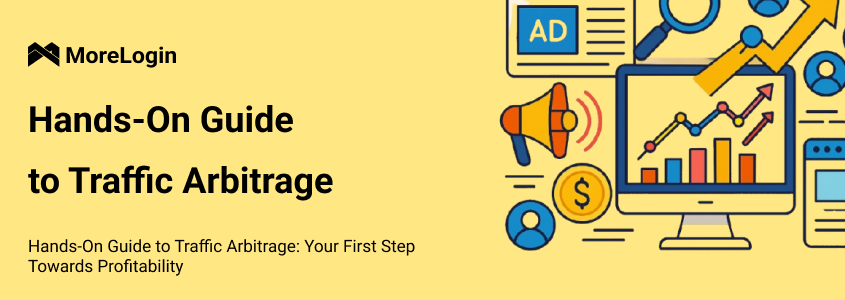
- Product

- Pricing
- Affiliate Program
- Use Cases
- Resource


Traffic arbitrage is a simple but powerful way to earn profit online. For example, a marketer buys 1,000 clicks for $10 and sends them to a page that earns $25 from ads. The result is a $15 profit. This model works because the cost of traffic is lower than the revenue it generates. Many businesses use traffic arbitrage to increase profits without selling products. This hands-on guide will explain what traffic arbitrage is, how it works, and how you can get started.
Traffic arbitrage is a digital marketing method. It involves buying low-cost traffic and sending it to high-earning web pages. The profit comes from the gap between the cost of buying the traffic and the revenue from ads or other monetization methods.
The core idea is simple: buy cheap, sell high — but for traffic.
People often misunderstand traffic arbitrage. They think it is a trick or a scam. In reality, it is a valid business model if used correctly. Many publishers and website owners use it to monetize their content.
A clear example: someone pays $0.01 per click on a native ad network and earns $0.05 per click on their site through Google AdSense. If they can maintain this margin, they earn a profit.
This model needs proper setup, tracking, and optimization. Without these elements, losses may occur.
There are many ways to do traffic arbitrage. Each method has its features and best-use cases. Below are the most common types:
This is the most popular method. You buy traffic from ad networks like Taboola or Outbrain and send it to a website filled with ads. The goal is to earn more from those ads than you spend on traffic.
You use platforms like Facebook, Instagram, or TikTok to buy traffic. The traffic is redirected to a landing page that earns through ads or affiliate offers. This model is fast and scalable.
This involves buying traffic for blog posts or articles and monetizing through programmatic ads or sponsored content. It works well for viral topics and news content.
This model sends paid search traffic (like Google Ads) to a webpage with monetized content. It requires tight optimization to be profitable.
Each type of arbitrage traffic has pros and cons. The best choice depends on your skills, budget, and risk tolerance.
Traffic arbitrage has many advantages for marketers and website owners:
Low Entry Cost: Starting traffic arbitrage requires only a small budget for testing campaigns.
Fast Revenue Generation: You can start seeing results in hours or days, unlike SEO or product-based models.
High Flexibility: You can shift between niches, platforms, or campaigns quickly.
No Product Needed: You do not need to create or stock any products.
Scalability: Profitable campaigns can be scaled to larger audiences.
These benefits make traffic arbitrage ideal for solo marketers, small teams, and digital entrepreneurs.
Understanding the traffic arbitrage process is key to success. Below is a simplified version of the typical steps:
Choose a Niche or Topic: Focus on trending, monetizable topics (e.g., health, finance, tech).
Create a Landing Page: Make a fast-loading page with quality content and ads.
Buy Traffic: Use ad networks like Revcontent or social media to drive traffic.
Monetize the Traffic: Use Google AdSense, affiliate offers, or sponsored placements.
Track Performance: Use tracking tools to measure cost-per-click (CPC), revenue-per-click (RPC), and profit margin.
Optimize Campaigns: Pause losing ads, scale winners, test new angles.
You must constantly test and optimize each step. Small changes can improve results significantly.

Some platforms are better for arbitrage traffic due to their reach, targeting capabilities, and pricing structures. Popular choices include:
Google Ads: Ideal for search arbitrage, but it requires strict policy compliance and detailed account control.
Facebook Ads: Excellent for precise audience targeting and scalable traffic delivery.
Taboola and Outbrain: Native ad platforms perfect for driving content-based traffic at scale.
Revcontent and MGID: Offer cheaper clicks, especially effective for long-tail or viral content campaigns.
Choose a platform based on your target region, content type, and cost constraints.
Here are some tested strategies for success in traffic arbitrage:
A/B Test Landing Pages: Test different headlines, layouts, and ad placements to improve performance.
Use Geo Targeting: Focus on countries where the cost-per-click is low, but ad revenue per user is high.
Monitor Click-Through Rates (CTR): High CTR on both incoming traffic and on-site ads increases profitability.
Avoid Clickbait: Misleading titles or exaggerated claims lead to high bounce rates and lower ad performance.
Leverage Multi-Account Tools: Managing several campaigns often requires separate ad accounts, browsers, or identities. In this case, tools like MoreLogin can help run multiple profiles in isolated environments. This makes account management safer and more efficient, especially when combined with AI automation such as in neural network tools used for arbitrage scaling.
Consistency and performance monitoring are essential. Every successful campaign starts with small tests and careful optimization.

While traffic arbitrage is legal, it must follow all relevant laws and ad policies.
Here are some common issues to avoid:
Misleading Ads: Do not promise false outcomes (e.g., fake weight loss claims).
Copyright Infringement: Do not use images, videos, or content without permission.
Click Fraud: Never engage in artificial clicks or traffic bots.
Privacy Violations: Respect data laws like GDPR and CCPA.
Always review the terms of ad platforms and stay updated on rules. Long-term success depends on legal and ethical practices.
Traffic arbitrage is a powerful way to earn money online. By buying low-cost traffic and monetizing it well, you can build a scalable and flexible income stream.
To succeed, you must understand how traffic arbitrage works, choose the right platform, and apply smart strategies. Tools like MoreLogin help you manage campaigns at scale. If you're ready to start your journey, follow this hands-on traffic arbitrage guide and begin testing your first campaigns today. Take your first step toward profitability with traffic arbitrage now.